Year End 2013
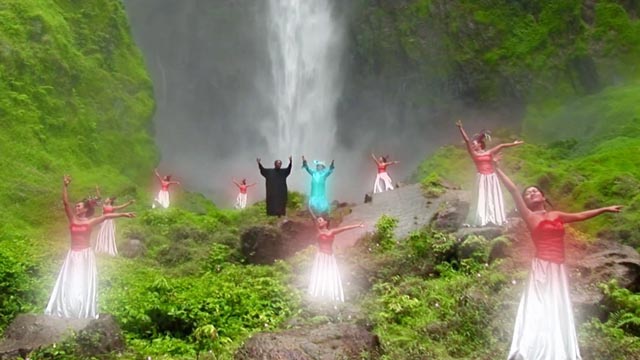
Continuing a long-running trend, the ratio of theatrical to home viewing this past year shrank almost to meaninglessness. Just twenty-two movies in a theatre (heck, when my documentary Going returned to the Cinematheque for a weekend in mid-December, I didn’t even stick around to watch it again after giving a brief introduction) versus almost four hundred on disk (plus a couple of hundred episodes of various TV shows – Futurama and South Park; another look at Joss Whedon’s Firefly after seeing Much Ado About Nothing; several classic and recent BBC series; about a fifth of Combat!; and even a couple of seasons of Xena: Warrior Princess) …
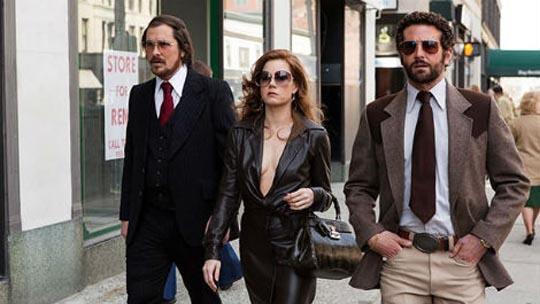
The only holiday release I got to was David O. Russell’s American Hustle which, although it feels a bit long, is enormously entertaining. Based on a famous FBI sting operation from the late ’70s in which agents hired a con-man as an adviser to set up a number of politicians for taking bribes, it focuses on schlumpy crook Irving (Christian Bale) and his partner/girlfriend Sydney (Amy Adams) as they’re blackmailed by ambitious agent DiMaso (Bradley Cooper) into luring New Jersey mayor Carmine Polito (Jeremy Renner) into the bribery scheme which eventually netted several Congressmen and a Senator … not to mention making dangerous connections with the Mob (in the form of a brief but chilling appearance by Robert DeNiro). As funny as the film is, it paints a bleak picture of America as a land where everyone is plagued by insecurity and a desperate need to be better, to be richer, to be someone other than who they are, and getting ahead involves using and ruining others by exploiting their similar insecurities and ambitions. Every character is conning every other character, and all of them are sinking deeper into dangerous situations and becoming more desperate as things inevitably go more wrong.
It’s a real pleasure to see a great cast create engaging characters with some real depth, speaking a whole lot of very well-written dialogue. There’s a loose, improvisational feel to the film which somehow manages to inspire everyone involved to do their best work yet (including Jennifer Lawrence as Irving’s manipulative wife Rosalyn). As elaborate as the cons and double- and triple-crosses are, most of the film consists of conversations in rooms; it almost feels like a rediscovery of the Golden Age of the talkies when all you needed was Bogart and Greenstreet and Lorre and Mary Astor verbally dancing around each other to create a world of wit and suspense.
Other than that, to keep it short, I would single out as big screen highlights of the year Guillermo Del Toro’s loving ode to childhood thrills, Pacific Rim; Joss Whedon’s Much Ado About Nothing (one of the most charming home movies ever offered to a paying audience); and – as if from a whole other universe – Joshua Oppenheimer’s documentary The Act of Killing (having just received the two-disk region 2 release, I’m bracing myself for another dip in that toxic pool with the director’s cut, 45 minutes longer than the theatrical version).
*
When it comes to home viewing, it’s hard to make a list of “the best disks of the year”, partly because there are so many angles from which to approach the idea of “best”. Much of my viewing tends to be of older disks which I’ve only recently come across and it seems like a real distortion to discount them because they weren’t released during the past year. Also, it’s never been my intention to make this blog any kind of “consumer guide” (there are countless sites on the Web which serve that purpose); it’s essentially just a way for me to talk about what I see and what my reactions are. In fact, I’ll probably be phasing out the more obvious reviews in the new year – most of these have been written for Blogcritics and re-posted here, but I’ve come to the conclusion that if I’m going to be writing so much for no monetary return, I’d prefer to do it for my own site rather than to support the advertising revenue of a large Internet company.
That said – on disk, my year’s viewing has been highly varied (and some might say incoherent). I’ve particularly enjoyed a selection of “small” British films like the Boulting Brothers’ Seven Days to Noon, High Treason and Twisted Nerve; Basil Dearden’s The Bells Go Down; and Seth Holt’s Nowhere To Go. Also the BFI’s series of Children’s Film Foundation releases, one-hour movies specifically made as an antidote to American product for kids’ matinees. Filmmakers like John Krish, Powell and Pressburger and Alberto Cavalcanti contributed to the series which ran from 1950 to the early ’80s, with stories ranging from the ordinary life of kids in the big city to adventures involving dastardly criminals to fantasy and horror.
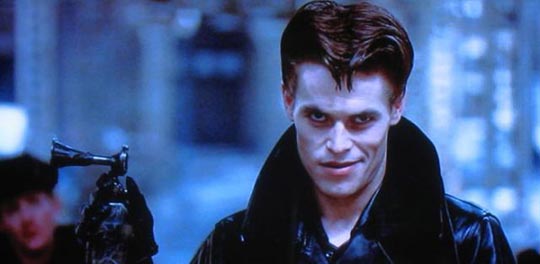
I would recommend two films as contemplations of the nature of movies and how we experience them (both on very nice disks from England): Streets of Fire (1984), Walter Hill’s cult follow-up to The Warriors, looks ravishing on Blu-ray from Second Sight Films. Conceived as an unreal fantasia on ’50s juvenile delinquent/rock’n’roll movies, Streets has the wispiest of storylines: popular singer Ellen Aim (Diane Lane) is kidnapped in the middle of a concert by a biker gang led by a disturbingly young Willem Dafoe, and her embittered ex-boyfriend Tom Cody (Michael Pare) comes back to town to rescue her. There are seething emotions, heated confrontations, and gleamingly wet night-time streets full of classic cars and massed bikes. The film is all about surfaces, the look of things (gorgeously photographed by Andrew Laszlo), and in hi-def those surfaces look spectacular. Streets of Fire bypasses the cortex and stirs its fingers in a more primal part of the viewer’s brain. It’s also one of those rare movies which manages to conjure up some authentic-sounding pop music (it’s not surprising that Ellen Aim sounds like a female Meatloaf – her big numbers were written and produced in bombastic hyperdrive by the Loaf’s former creative partner Jim Steinman). As an added bonus, Pare is given a feisty sidekick played by Amy Madigan, who persuaded Hill to change the role from male to female, a very smart move as she ends up giving the movie much of its spice.
Replacing Hill’s shimmering surfaces with dark interiors, Peter Strickland’s Berberian Sound Studio seems to begin in something resembling the real world, but ends up inhabiting a totally subjective space, trapped inside the head of a protagonist (the fascinating Toby Jones) as he slides inexorably into madness. Taking place almost entirely inside a sound studio during the dubbing and mixing of a sleazy ’70s Italian horror movie, it makes palpable the crucial role of sound and the viewer’s imagination in giving movies the strange visceral power they have over us.
*
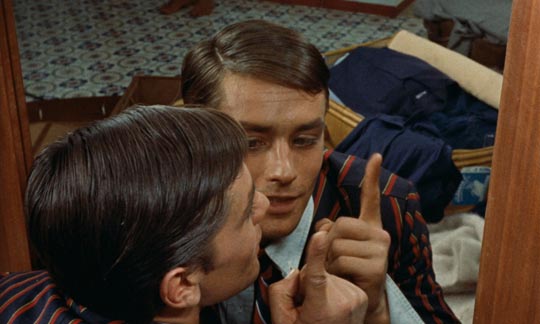
This was a big year for French filmmaker Rene Clement, who for a long time had fallen out of favour thanks to the disdain of the New Wave critics/filmmakers. Criterion brought out a beautiful Blu-ray edition of Purple Noon (1960), his adaptation of Patricia Highsmith’s The Talented Mr Ripley. While the supplements were good, the Cohen Collection Blu-ray edition of Clement’s post-war submarine film The Damned (1947) was even better, with a one-hour documentary in which various critics, historians and filmmakers went a long way towards restoring the director’s reputation not only as one of the foremost French filmmakers of his time, but also as a key precursor to the New Wave itself. Less significant than these disks, but not without interest, is the Optimum/Studio Canal region 2 DVD of Rider On the Rain (1970) from the late period during which, like many European filmmakers, Clement was making “international” movies with American stars or co-stars. This tricky thriller used Charles Bronson as a box office draw, but it’s the performance of Marlene Jobert as a woman who kills her rapist which gives the film its stature.
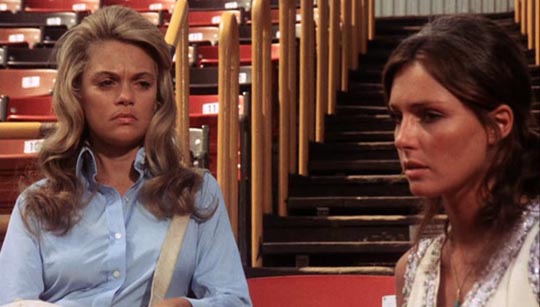
Speaking of filmmakers whose reputation declined in their later years, Olive Films’ three-disk Blu-ray collection of late Otto Preminger features offers a fascinating look at a great director who seems to have lost touch with the times and society he’s working in. At least, that’s the case with the turgidly entertaining Hurry Sundown (1967), a steamy melodrama about decadence and racism in the post-World War Two South, and Skidoo (1968), a bizarre “counter-culture” slapstick comedy (from a script by Doran William Cannon, who a couple of years later gave Robert Altman the basis for Brewster McCloud); this classic car crash of a movie is so relentlessly unfunny that it almost stands as a monument to anti-comedy, destroying everything in its path through an aggressively purposeful refusal to understand the social upheavals of the time. By the time Preminger made Such Good Friends (1971), his critical reputation was in ruins and this, his finest late-career production, was poorly received; a bitter comedy of manners set among upper middle class New Yorkers, it may have seemed trivial at the time for avoiding “important” issues, but this story of a woman whose life is overturned when her husband suffers a catastrophic illness and she gradually discovers that he and her friends were never the people she believed them to be is so well directed and performed by its excellent cast, that it reminds us of what made Otto such a prominent and influential filmmaker in the ’40s and ’50s. Indeed, even the previous two misfires exhibit a level of craft which puts less talented directors to shame.
Oliver Stone is perhaps as controversial as Preminger, but I seldom find his films as entertaining as Otto’s. However, I really enjoyed his massive 10-hour monologue with pictures, The Untold History of the United States (12 hours if you count the two un-aired prologues). To an observer from outside the U.S., Stone’s lesson in 20th Century American history doesn’t offer a great deal that isn’t familiar (though there are numerous small, interesting details which he offers to support his arguments), but it’s refreshing to realize that beneath the relentless right-wing chatter which seems to be the only voice we now hear there are other Americans who are fully aware of the realities of U.S. policy and the ways in which it has harmed numerous other countries, providing a quite rational basis for what so many Americans still strangely see as inexplicable distrust and hatred.
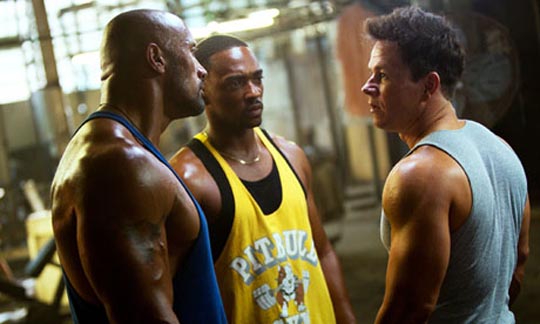
Michael Bay is a filmmaker who will never gain the respect of a Preminger or even a Stone (full disclosure: I’m a committed fan of The Rock, Armageddon and The Island), and yet this year he took time out from his exhausting and tedious Transformers franchise to make what for him was a low-budget, personal movie. Pain & Gain (2013) has all the surface flash we expect from Bay, but it also manages to transform his crass style into a critique of the crass society which has given rise to it. The mindless opportunism of the characters (played full-throttle by Mark Wahlberg, Dwayne Johnson and Anthony Mackie) perfectly embodies the ideal of completely self-interested individualism which is the inevitable personal end of the forces described in Stone’s documentary series, an expression of the belief in exceptionalism which justifies any action if it brings personal (or national) gain. But alas, this appears to be a minor aberration in Bay’s career as his follow-up is another Transformers movie, with Bad Boys 3 on the distant horizon.
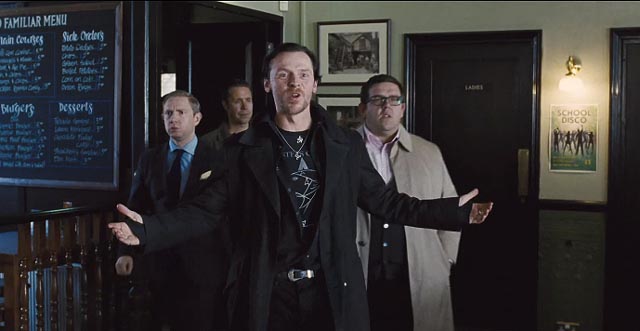
I’m not a big fan of Edgar Wright’s work. I thought the first half of Shaun of the Dead was brilliant, but lost interest when it settled down to zombie-movie routine in the back end; while Hot Fuzz had some individual funny moments, its aim to be a British Jerry Bruckheimer action-fest seemed tired and pointless. So, given the poor reviews, I didn’t even bother to get out to see The World’s End. However, I did end up taking a look when it came out on disk and discovered, against expectations, that it’s the best thing Wright and Simon Pegg have done. Like the previous two films it blends the ordinary horrors of life in contemporary Britain with fantastic elements (in this case, alien invasion), but more than the other films it’s firmly rooted in character and the characters are genuinely engaging, starting with Pegg’s appalling Gary King, the big man at school who never grew up and is descending into a desperate middle age clinging to memories of past glory – pathetic memories which mostly revolve around getting blind drunk as an adolescent. Gary tricks and manipulates his long-ago moved-on friends (Nick Frost, Martin Freeman, Paddy Considine, Eddie Marsan) into returning to their awful hometown to relive the epic pub crawl they failed to complete just after they left school. The others have all got on with lives which offer their fair share of pleasures and disappointments, but the journey home brings out all the rueful self-examination and regrets about unfulfilled promise that trying to go back inevitably inspires. And then they run into the alien robots who have taken over much of the town Body Snatchers-like.
But the remarkable thing about The World’s End is that even as the sci-fi mayhem escalates, the film never loses sight of the characters and their personal issues; the late revelation that Gary has attempted suicide and been in a psych ward because real life is just too much for him retrospectively illuminates everything which has led the gang to their current precarious situation, and the apocalyptic ending, while seemingly inevitable in its genre terms, is as chilling as it is funny because it offers the hopeless possibility that the only way to cope with a world which is too much for you is to destroy it to preserve your illusions about yourself. This is a much deeper, more resonant and satisfying film than either of its predecessors.
Douglas Hickox’s Zulu Dawn (1979) was conceived as something of a corrective to the apparent valorization of British colonialism in Cy Endfield’s Zulu (1964). Spectacularly filmed on the actual South African locations, it dissects the arrogance and stupidity which were an inherent part of colonial rule, but as the supplements on Severin’s Blu-ray reveal, the production was almost as chaotic as the original military adventure, which perhaps explains why, for all its accomplishments, it doesn’t rise to the grandeur of Endfield’s original film.
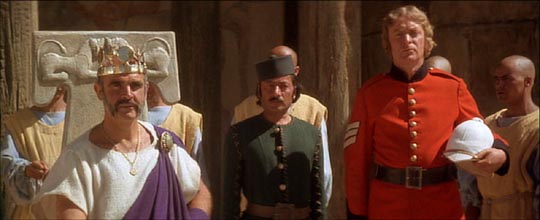
John Huston, in adapting Rudyard Kipling’s story, took a less obviously critical approach to the subject of colonialism in The Man Who Would Be King (1975), which I just re-watched on Warner’s Blu-ray from a couple of years ago. This shimmeringly colourful adventure has at times been accused of perpetuating racist attitudes, largely because it tells its story through the eyes of its two Cockney soldiers who dream of ruling a kingdom high in the mountains of Northern India. A superficial reading might interpret the depiction of the native population (a harsh, warlike people given to what our heroes see as uncivilized atrocities – like playing polo with the severed heads of their enemies) as problematic. And Huston, an old-school director for whom the story was paramount, doesn’t lay out the political implications of Kipling’s tale as obviously as Hickox depicts the British in Zulu Dawn; but the point of The Man Who Would Be King is the essential madness of the whole colonial enterprise and the ways in which the would-be conquerors are deformed and ultimately destroyed by their own greed and arrogance.
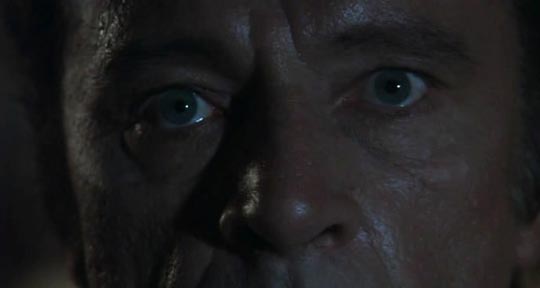
Other highlights of the year (many of which I’ve previously written about here): Paul Thomas Anderson’s The Master; Nicholas Ray’s Johnny Guitar; Robert Aldrich’s Twilight’s Last Gleaming; Elia Kazan’s Wild River; Jack Gold’s The Medusa Touch (an old favourite generally held in low esteem); Edgar G. Ulmer’s Green Fields; Don Coscarelli’s John Dies At the End; the films of Czech animator/fantasist Karel Zeman – particularly The Fabulous World of Jules Verne (I’ve just received two more titles from the Muzeum Karla Zemana: The Stolen Airship [another Verne adaptation] and the more classically animated The Sorcerer’s Apprentice). And the evolution of horror in the movies is thrown into relief by the new Blu-ray editions of Universal Classic Monsters: The Essential Collection, Hammer’s Curse of Frankenstein and Dracula, Roger Corman’s House of Usher, and Brandon Cronenberg’s Antiviral. The BFI edition of Anthony Asquith’s Underground was a revelation – it’s amazing how we can still discover such remarkable things from the silent era which (in our arrogance) we tend to believe we have exhausted by now.
Finally, it’s been a particularly rich year for Criterion releases. In the Eclipse line, I’ve watched When Horror Came to Shochiku and Masaki Kobayashi Against the System. Then there were excellent editions of Rouch and Morin’s Chronicle of a Summer, Hitchcock’s The Man Who Knew Too Much (1934 version), Harold Lloyd’s Safety Last, Paul Fejos’ Lonesome, Lewis Allen’s The Uninvited, Ernst Lubitsch’s To Be or Not To Be, William Cameron Menzies’ Things To Come, Haskell Wexler’s Medium Cool and Elio Petri’s Investigation of Citizen Above Suspicion.
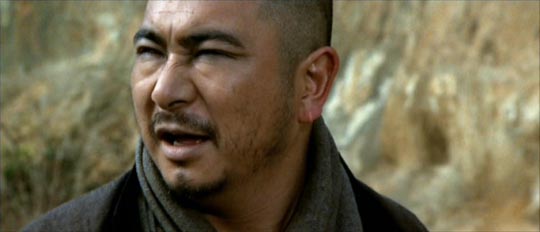
While perhaps the most important release of the year for serious cinephiles was the content-rich box set, 3 Films by Roberto Rossellini Starring Ingrid Bergman, for me personally the company’s most spectacular release is the massive box set of 25 Zatoichi films (on both Blu-ray and DVD). I’ve only had time to re-watch the first three features so far, The Tale of Zatoichi, The Tale of Zatoichi Continues (both 1962), and New Tale of Zatoichi (the first of three episodes made in 1963). When Daiei Studios made the first film in 1962, based on a very short story by Kan Shimozawa, which in turn was based on fragments of an actual history, it was considered a minor, routine effort. But the story of the blind masseur who is also a great swordsman was an instant hit and Daiei rushed out a sequel (which is even better than the first film) and a cultural hero was born. A total of 25 features were made by 1973, followed by a hundred episodes of television and a final elegiac feature written and directed in 1989 by the series’ star Shintaro Katsu (which, sadly, Criterion didn’t include in the set).
The first two features, shot in glorious widescreen black-and-white, make use of many traditional elements of the Japanese swordplay genre, but the modest scale of the productions precludes the grand impressions offered by many better-known examples by Kurosawa and others. There’s something about the early Zatoichi films which naturalizes the historical period, their characters more lowly, the details of the lives depicted more quotidian. The mood is melancholy (perhaps a little reminiscent of Yoji Yamada’s magnificent late-career trilogy which began with The Twilight Samurai [2002]); we learn only fragments of Ichi’s background, his humble demeanour seemingly an effort to atone for past sins as a gambler and yakuza (although he hasn’t given up the gambling, he has a deep disdain for the gangsters who prey on poor peasants and villagers). The films are steeped in the codes of honour we know from other samurai films, but most of the characters are far from that ethos; the peasants struggle to survive, the gangsters are low and vicious. These are working class stories rather than tales of Japan’s nobility. It seems fitting that someone like Ichi, who exists at the bottom of the social heap – a poor, homeless, blind man surviving by his wits and his skills as a masseur, and when necessary, although usually reluctantly, by his formidable skills with the sword concealed in his walking stick – becomes the focus of an implicit critique of a failing social order.
The third film, New Tale of Zatoichi, clearly indicates that Daiei knew they had a property with long-term potential; an increase in budget permitted filming in colour (though, personally, I think this a step back because colour more clearly reveals the studio sets for what they are). They also came up with a story which shows us more of Ichi’s background as he returns to the village where he trained as a swordsman and is tempted to put his life of crime and violence behind him when he meets Yayoi, the now-grown-up younger sister of his master Banno. Banno, so proud of Ichi’s skill, reveals his contempt for the blind man’s social inadequacy, refusing to give permission for Yayoi to marry the masseur because it would sully his own standing. But that standing rests on a lie; Banno is himself a criminal and in the climactic moments of the story Ichi must confront not only a violent gang but also Banno himself, the resulting slaughter simply proving that he can’t put his past behind him … and the film ends, as so many of them do, with him walking off alone into the distance.
Through Katsu’s ever-deepening performance as the series continued, the character takes on the richness of theme and emotion we see in Kurosawa’s Ran and Ikiru, the weight of a social order which oppresses and cripples the lives of the people caught up in it – and yet Ichi always tries to do what’s right, helping those in need in whatever way he can.
With another 22 Zatoichi movies to go and an accumulating pile of new disks waiting for my attention, I guess 2014 won’t see any slackening of my viewing pace.
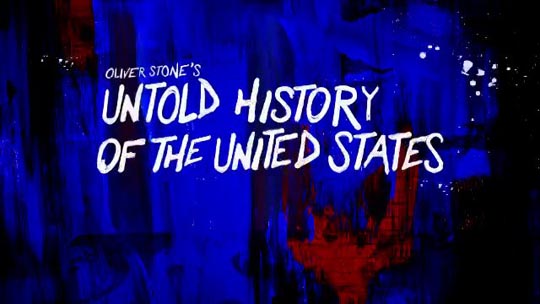
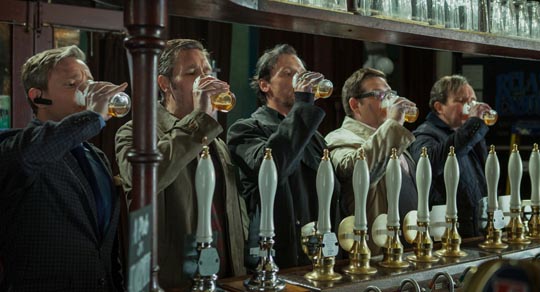
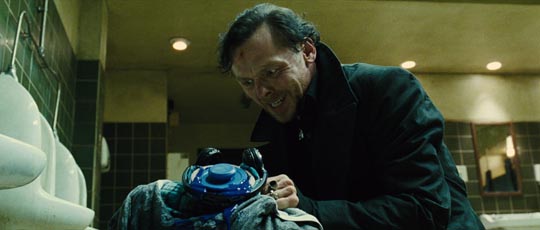
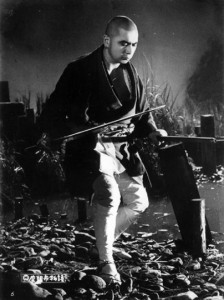
Comments